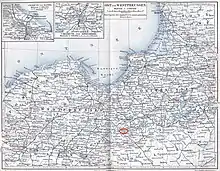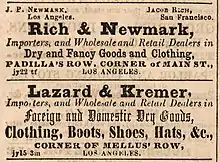Harris Newmark
Harris Newmark (July 5, 1834 – 1916) was a Prussian-American businessman, philanthropist, and historian. Born in the West Prussian city of Löbau (now Lubawa, Poland), Newmark emigrated to the United States in 1853, sailed from Europe to New York City to San Francisco, and finally settled in Los Angeles. The Newmark clan was one of the founding families of the Los Angeles area.[1]
Harris Newmark | |
|---|---|
 | |
| Born | July 5, 1834 Löbau, West Prussia (now Lubawa, Poland) |
| Died | 1916 |
| Nationality | Prussian American |
| Occupation | Businessman philanthropist |
| Spouse(s) | Sarah Newmark (cousin and wife) |
| Children | Maurice Harris Newmark |
| Parent(s) | Phillip Newmark Esther Newmark |
| Relatives | Joseph P. Newmark (brother) Nathan newmark (brother) Joseph Newmark (uncle and father-in-law) Joseph P. Loeb (grandson) |
| Signature | |
Newmark's memoir, Sixty Years in Southern California: 1853–1913,[2] has been cited in dozens of academic papers and books, and is considered to be the Los Angeles equivalent of a Pepys diary.[1][2][3][4]
Early years

Newmark was the son of Phillip and Esther Newmark.[5] Phillip Newmark was born in Neumark, West Prussia, and traveled to Sweden and Denmark to sell his ink and blackening products. He made a sales trip to New York City in 1837, but became ill and returned home in 1838. His son Joseph P. Newmark, Harris's brother, emigrated to California in 1848, and beckoned Harris to follow. Many Newmark relatives already resided there.[1] Newmark took the advice, and sailed for New York City. He then boarded a second ship for California, crossed the isthmus of Nicaragua with Leopold Harris, who would found the Harris & Frank department stores, and arrived in San Francisco in October 1853. He eventually made it to Los Angeles, where he took his first American job as a clerk for his brother Joseph P. at his partnership Rich & Newmark, a dry goods emporium.

At the time, Newmark had limited English-language skills; he spoke German, Swedish, and had picked up the Spanish language while en route to and in California.
In 1854, his uncle Joseph Newmark arrived in Los Angeles with his wife and six children. They provided Newmark with a home, and his aunt taught Newmark how to read, write, and spell in English. On March 24, 1858, he married his cousin Sarah in the family home; his uncle Joseph officiated, and consequently became Harris' father-in-law.[6]
Businessman
Newmark developed several successful businesses, which employed most if not all of a near-inexhaustible list of Newmark family members.[1] Newmark was chiefly a grocer and dry goods merchant, but he also dabbled in other fields. He even tried sheep farming,[6] but he was preoccupied with the burgeoning real estate opportunities to be had in the Los Angeles area. Newmark bought and sold properties throughout southern California, and made a fortune in the process.
Upon arrival in Los Angeles he clerked for his brother Joseph P. at Rich & Newmark. In 1854, he opened a clothing store on south side of Commercial St. and east of Main St. in what had been the Prudent Beaudry building owned by Mateo Keller. For eight years he had several partners in this venture. In 1862, he went into the commission business instead.[7]
At the end of 1885, Newmark retired from the grocery business to devote more time to his real estate and investment pursuits. In 1886, he and five well-known businessmen—Newmark, his nephew Kaspare Cohn, John D. Bicknell, Stephen M. White, and I.W. Hellman—purchased a 5,000-acre (20 km2) ranch located in East Los Angeles called Rancho Repetto.[1] The land had been owned by an Italian settler named Alessandro Repetto, who bequeathed the ranch to his brother Antonio. Newmark's group bought the inheritance for US$60,000, or about $12 per acre.[8]
In May 1899, Newmark subdivided the tract owned by himself and his nephew, after contracting with William Mulholland to design and construct a suitable water system for the new settlement.[9] Accounts differ on the actual size of Newmark and Cohn's parcel, but it was somewhere around 1,200 to 1,500 acres (6.1 km2).[8][10] A piece of this tract adjacent to the tracks of the San Pedro, Los Angeles & Salt Lake Railroad was developed into a town site called Newmark. The remaining land was subdivided into 5-acre (2.0 ha) lots suitable for small-scale agriculture. The entire settlement, including the Newmark town site, was given the name Montebello.[9] When the town incorporated in 1920, Montebello replaced Newmark as the new city's name.[1][8][11]
Legacy
Newmark made many contributions to the economy and culture of Los Angeles, and gave his time and his money to causes he felt were worthy. He was one of the founders of the Los Angeles Public Library, was a charter member of the Los Angeles Chamber of Commerce, and was one of the organizers of the Board of Trade, which helped bring railroad service to California.[12] He was the president of Congregation B'nai B'rith in 1887 (he inherited the title from his uncle and father-in-law Joseph Newmark)[1] and a founder of the Jewish Orphans Home of Southern California.[12] Newmark was also instrumental in the establishment of the Southwest Museum, which is now part of the Autry National Center.[2] He and other Newmarks were leaders of the local Odd Fellows and were Masons.[1][13]
Newmark's memoir, Sixty Years in Southern California, was assembled with the assistance of his sons and a Pasadena historian. It has been called "one of the great autobiographies" by an American Jewish writer, and "the single most valuable memoir" about southern California in the nineteenth century.[2] The American Memory project of the Library of Congress has the entire memoir available online.
Harris Newmark High School, a continuation high school in the Los Angeles Unified School District is named in his honor, as is the Harris Newmark Building in downtown Los Angeles. Now called the New Mart building, the edifice was the first high-rise structure in the city, and was built in 1928 by Newmark's sons. [[The Braly Block at Second and Springs streets was the city's first highrise, circa 1904. Between then and the late 1950s, the only higher building that was allowed constructed was city hall. The city council imposed a height limit of 150 feet at the height of the city beautiful movement]][14]
Newmark was the grandfather of Los Angeles lawyer Joseph P. Loeb, who also proofread his memoir book.
References
- Rochlin, Harriet; Rochlin, Fred (July 5, 2000). Pioneer Jews: A New Life in the Far West. New York City: Houghton Mifflin. pp. 126–129. ISBN 0-618-00196-4.
- Greenstein, Albert (1999). "Harris Newmark". SoCalHistory.org. Historical Society of Southern California. Archived from the original (excerpt) on August 6, 2007. Retrieved September 30, 2007.
- Harlow, Alvin Fay (1934). Old Waybills: The Romance of the Express Companies. New York City: Arno Press. p. 441. ISBN 0-405-07692-4.
- McWilliams, Carey (August 1, 1994). Southern California: An Island on the Land. Salt Lake City: Peregrine Smith Books. p. 45. ISBN 0-87905-007-1.
- "Chapter I – Childhood and Youth 1834–1853". Sixty years in Southern California, 1853–1913, containing the reminiscences of Harris Newmark. Library of Congress American Memory project. Retrieved September 30, 2007.
- "Chapter XVI - Marriage – The Butterfield Stages 1858". Sixty years in Southern California, 1853–1913, containing the reminiscences of Harris Newmark. Library of Congress American Memory project. Retrieved July 30, 2007.
- Newmark, Marco R. (1942). "Pioneer Merchants of Los Angeles". Historical Society of Southern California. doi:10.2307/41168008. JSTOR 41168008.
- "History of Montebello". City of Montebello. Archived from the original on September 22, 2007. Retrieved September 30, 2007.
- "Chapter XXXVII – Repetto and the Lawyers 1885–1887". Sixty years in Southern California, 1853–1913, containing the reminiscences of Harris Newmark. Library of Congress American Memory project. Retrieved July 30, 2007.
- "Pride in the Past, Faith in the Future" (PDF). Langley Senior Citizens Center newsletter. Monterey Park Historical Society. December 1, 2005. Archived from the original (PDF) on October 28, 2007. Retrieved September 30, 2007.
- Rasmussen, Cecilia (July 29, 2007). "City names stem from trees, ranches – even a goddess". Los Angeles Times. pp. B2. Retrieved October 26, 2007.
- Pawlak, Debra Ann (2011). Bringing Up Oscar: The Story of the Men and Women Who Founded the Academy. New York, NY: Pegasus Books. ISBN 978-1605981376. Retrieved December 16, 2017.
- "Chapter IX – Familiar Home Scenes 1854". Sixty years in Southern California, 1853–1913, containing the reminiscences of Harris Newmark. Library of Congress American Memory project. Retrieved July 30, 2007.
- "History of Building". Newmart.net. Archived from the original on September 29, 2007. Retrieved September 30, 2007.
External links
- Works by Harris Newmark at Project Gutenberg
- Works by or about Harris Newmark at Internet Archive
- Works by Harris Newmark at LibriVox (public domain audiobooks)

- Harris Newmark Family – Jewish Genealogical Society of Los Angeles
- Los Angeles Jewish History timeline of Jewish history, including Newmark contributions
- photo of the Harris Newmark Building
- City of Montebello, California
- Harris Newmark at Find a Grave